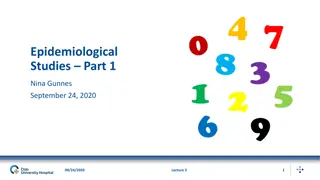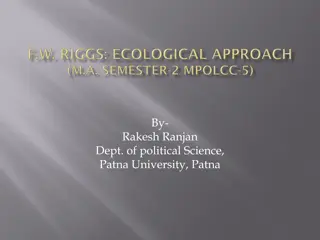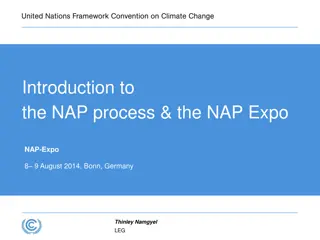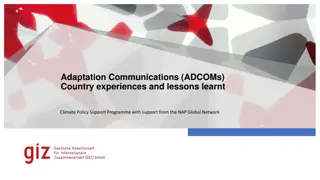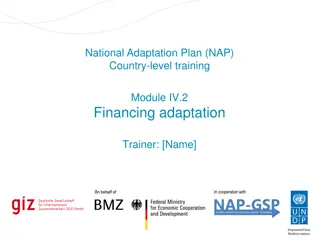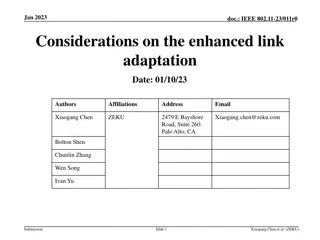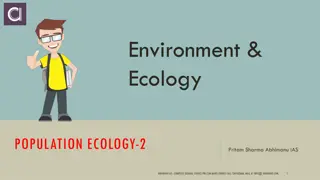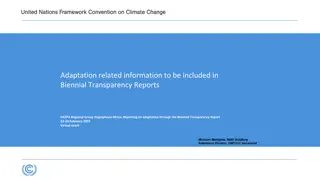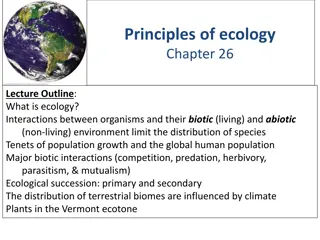Understanding Population Dynamics and Adaptation in Ecological Systems
Population size and distribution are influenced by various factors such as competition, predation, migration, diseases, and natural disasters. Populations adapt to their environments to survive and reproduce, facing struggles like finding food, water, shelter, and protection against predators and diseases. Well-adapted organisms have a better chance of surviving and reproducing in their habitats, highlighting the importance of adaptation in ecological systems.
Download Presentation

Please find below an Image/Link to download the presentation.
The content on the website is provided AS IS for your information and personal use only. It may not be sold, licensed, or shared on other websites without obtaining consent from the author. Download presentation by click this link. If you encounter any issues during the download, it is possible that the publisher has removed the file from their server.
E N D
Presentation Transcript
Population size A population is the number of a species living in a particular area
What factors could change a population? Competition For food, water and space Predators will eat prey and reduce the population (including the number of offspring) Members of the population may leave the area A disease could kill some of the population Predation Migration Disease Drought, fire, floods, volcanic eruptions etc could alter the habitat and affect the population Wars can result in the death of many members of a population Natural disasters War
What else can affect the numbers and the distribution of a population? How well are individuals adapted? This will affect their survival in a habitat. What else lives there? This may mean competition for food. There may be predators.
What is adaptation? Adaptation describes how a plant of animal is able to survive in various environments Well adapted organisms can cope with the different aspects of their environment, for example, the temperature
It is always a struggle for plants and animals to survive ANIMALS STRUGGLE : For food For water For protection against weather Against being eaten by predators Against disease Against accidents PLANTS STRUGGLE: For water For light For minerals in the soil Against weather Against disease Against being eaten
How does adaptation help organisms? Well adapted organisms are better at coping with extremes of weather They are better at competing for food They are better at escaping from predators They are more likely to survive in their habitat and produce offspring
An arctic habitat This sort of habitat can have extremely low temperatures The ground is covered with white snow for most of the year
How are animals adapted to survive in the Arctic? Animals like polar bears will have a thick insulating coat They usually have a large amount of body fat They have a large body size to surface area
How do these adaptations help? A thick fur coat Traps heat to keep warm Large body size to surface area ratio Reduces heat loss by radiation Acts as a food store and to keep warm A large amount of body fat
A desert environment A desert can have very little rainfall There is a lot of sunshine during the day There is very little shade The temperatures can get very hot
How is a camel adapted to survive in the desert? Camels can store large amounts of water in the fat in their humps They have feet with a large surface area to allow them to walk on sand They also have long eye-lashes to
How do reptiles survive in the desert? Most reptiles will find some shade under a rock during the hottest part of the day When walking on hot sand a lizard will try to touch the ground with only a small area This lizard keeps swopping feet, and only stands on two feet at a time
How do plants survive the desert? A cactus has a long tap root to reach water deep under the ground It has a thick, fleshy stem to store water It has needle- shaped leaves to prevent water loss through the stomata The needles help to stop animals from
This powerpoint was kindly donated to www.worldofteaching.com http://www.worldofteaching.com is home to over a thousand powerpoints submitted by teachers. This is a completely free site and requires no registration. Please visit and I hope it will help in your teaching.
This powerpoint was kindly donated to www.worldofteaching.com http://www.worldofteaching.com is home to over a thousand powerpoints submitted by teachers. This is a completely free site and requires no registration. Please visit and I hope it will help in your teaching.


